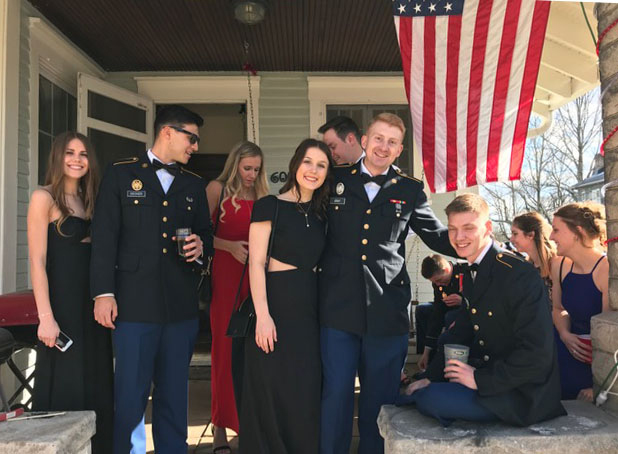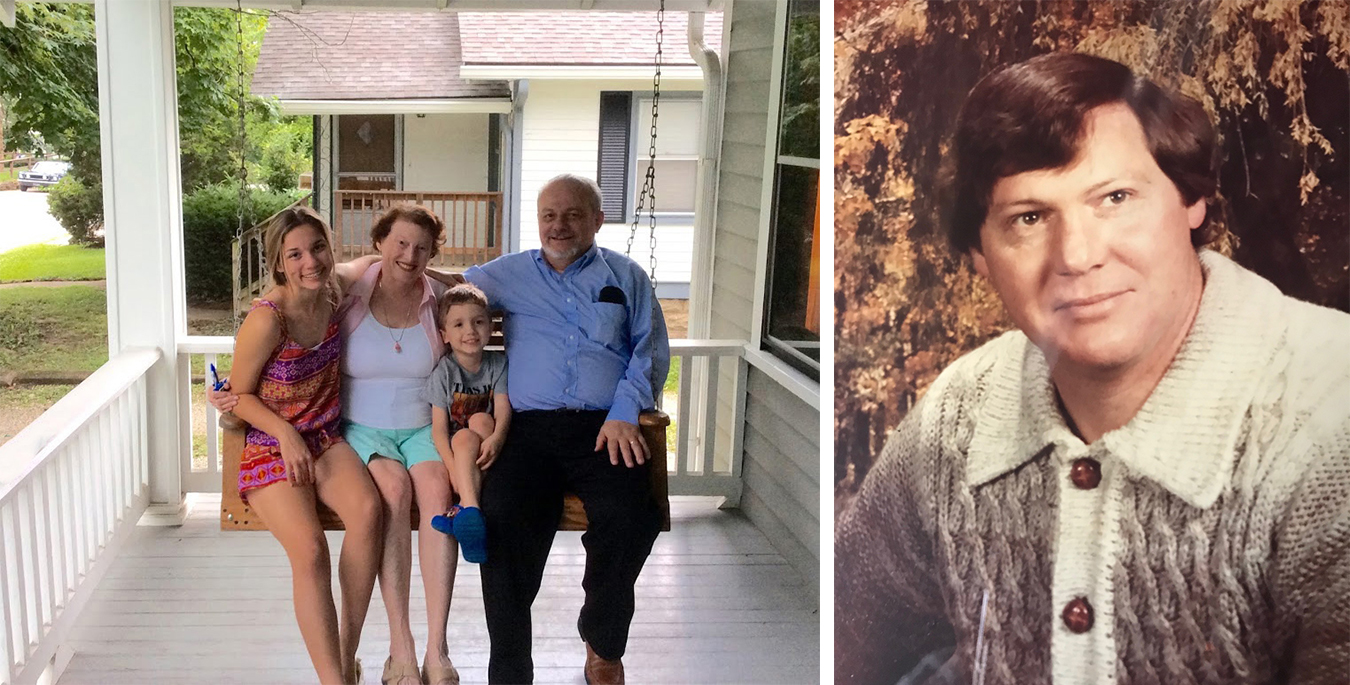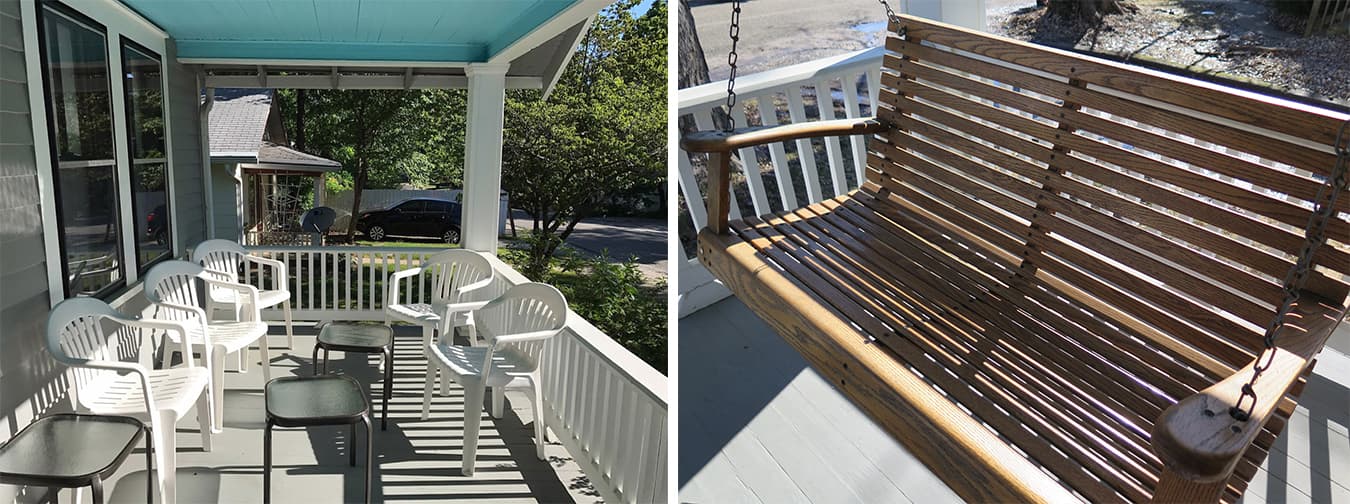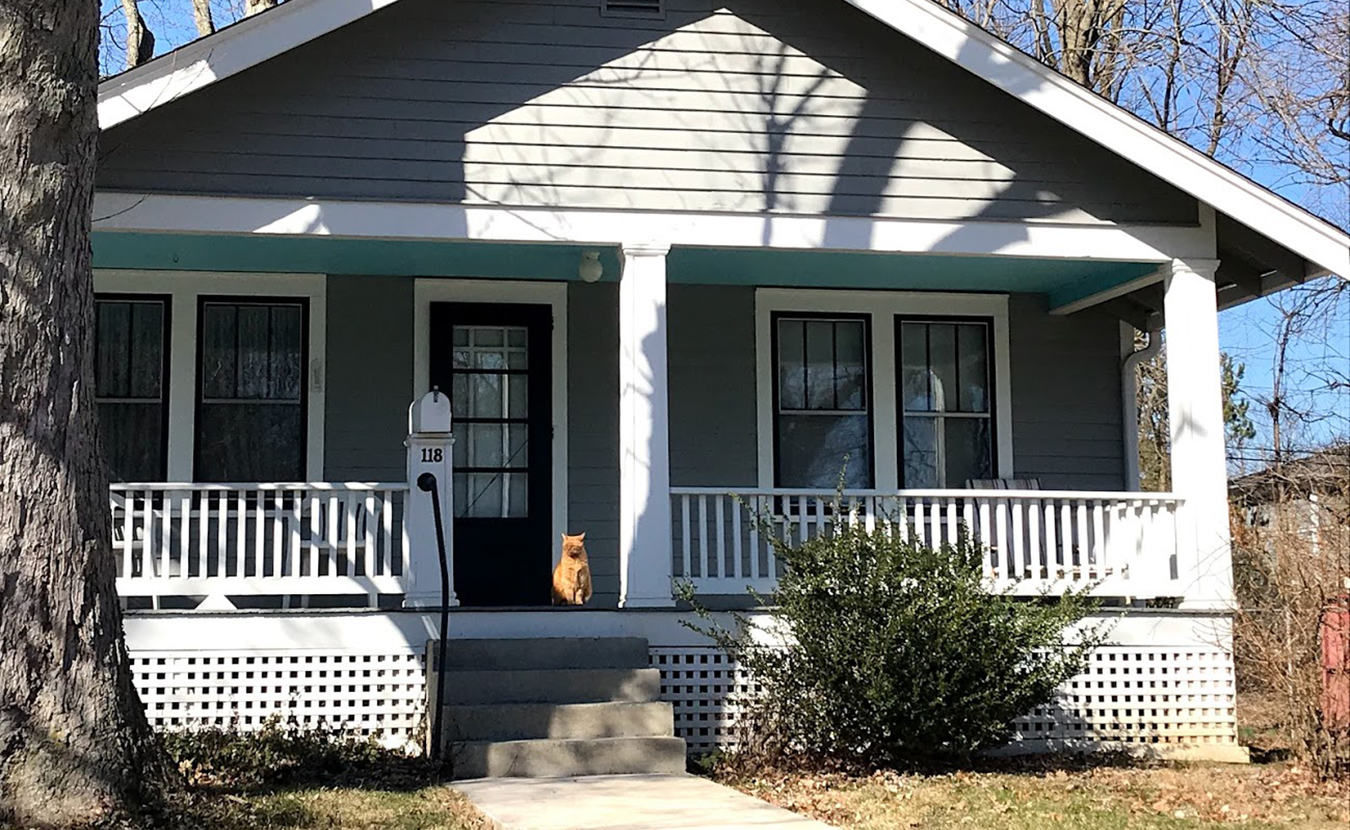Let’s take a slightly fuzzy view of time, one that does not pinpoint an event in Bloomington’s history or call to mind a famous person’s birth or death. Instead, let’s sit back and consider those swing-adorned, street-facing structures that line so many of Bloomington’s streets, our front porches. Where did they come from and how do we use them now?
My husband and I use our front porch spring, summer, fall, and maybe even on a warm winter day — for reading the paper, chatting with neighbors, having a party with friends, or just relaxing on our swing. Our cat Beppo likes the porch, too, for basking in the sun and surveying the neighborhood.
If you walk or drive around our central neighborhood, you will often find 8 to 10 front porches in each block. In fact, the bungalow was the most common type of house built in Bloomington before the 1950s, most of them between 1905 and 1940. And with the bungalow came front porches. The City of Bloomington Interim Report, written in 2004 and containing a history of Bloomington’s residential architecture, calls our streets “a staccato pattern of bungalow porches,” which brings an “energetic sense of community.” So let’s back up to the early 20th century, when front porches first became popular. It was a time when working-class families were finally able to afford an individual house, when kits and plans for building these houses were commonly available to Bloomington builders, and when builders could individualize these plans to suit a family’s desires and means. Walk down South Washington Street and you can see the distinct architecture of these porches.

(left) South Washington Street displays the distinct architecture of porches built in the early 1900s. (right) The 2014 houses on South Morton Street, along the B-Line Trail, mirrors the same staccato pattern. | Photos by Harriet Castrataro
You can find the same staccato pattern in the houses built in 2014 on South Morton Street along our B-Line Trail. This 21st-century renaissance of front porches shows us that they fill a special niche in our town. It’s a niche that was created in an era when the middle class could finally afford homes of their own and a niche that lives on as present-day residents find a variety of uses for their front porches both old and new.
Many scholars have weighed in on the significance of the front porch. The two most common ideas are that it is a liminal space, a space between two worlds, and that it is a place where people’s sense of community is fostered. Imagine a time here in Bloomington when there was neither air conditioning nor television. People would likely walk down the street, greeting their neighbors and maybe stopping to sit a spell. A front porch scholar, Sue Bridwell Beckham, says that, in the past, on the porch the whole family and their neighbors experienced a sense of community: “There betwixt and between absolute private and absolute public, relationships that would be impossible elsewhere can flourish.” In the old days, young people who were courting could be together on the front porch and, as Beckham puts it, “bashful and protected youth in the first flush of intimacy are free to experiment with new relationships.” We can be sure that early residents of Bloomington, especially the young college students, did find this growing intimacy in social relationships on their front porches. We still do.

Castrataro came across a porch party that “gives us a glimpse of the timelessness of front porches.” | Photo by Harriet Castrataro
Recently, I happened upon a party on a small porch at 600 E. 2nd Street, where the students were dressed up for their ROTC ball. The pre-ball celebration was lively, with the students smiling at one another and posing for my photos. One can see the social connections in the photo as they laugh and put their arms around one another. They said that they had rented this house especially for its front porch. It was the first sunshine in a week, and the excitement of a pre-ball open-air party was contagious. The scene is not so different from the courting rituals of the past — young people on their front porch trying out new social roles together.
This photo gives us a glimpse of the timelessness of front porches, the sense of protection they hold between the inside and the outside, and the arena they provide for growing social relationships and a sense of community.
Children sense this naturally. In Bloomington, I found kids’ toys on many front porches. At a house on the Near West Side, I spoke with Leora Baude about her front porch, which was full of kids’ toys. From the photo I took, one can see that there are trucks, a bike, and a couple of sleds ready for action.

(left and center photos) Leora Baude’s front porch on the Near West Side is a haven for her kids and their toys. (right) The porch of the James Clawson family along the B-Line Trail is an example of how families use modern front porches. | Photo by Harriet Castrataro
I spied another kid porch in the newer B-Line Trail porch neighborhood. Renter James Clawson told me that he and his wife chose their home specifically for the front porch. There were Easter flowers ready to be planted, a toddler seat strapped to one of the chairs, and even some chalk drawings on the wall, a vivid illustration of the way young families use their modern front porches.
A front porch swing is special too. There are swings on front porches all around town. They bring us leisure in a busy world. To discover the connection between front porches and leisure, I interviewed Vernon L. Mefford, master swing builder and owner of Swings by Mefford. Since 1980, Mefford has offered porch swings for sale, displaying them out in front of his home at 4977 E. State Rd. 46. He designed the swings for comfort, with lumbar support, curved armrests and seat fronts, and solid oak wood. In fact, Mefford says these ideas came to him when he went to a hardware store one day and discovered that there wasn’t a single swing for sale that he would want a visitor to sit on. He has never advertised and has been selling swings for nearly 40 years, though he is now semi-retired.

(left) Castrataro says, “Like front porches, swings are liminal, between two states: motion and stillness. And they are great spaces for families and kids. Here I am with my husband and grandkids on our Mefford porch swing.” (right) Vernon L. Mefford, master swing builder and owner of Swings by Mefford, in his earlier years. | Courtesy photos
Mefford believes that swings have “a direct effect on people’s happiness,” and that they are therapeutic, especially in solitude when their slow motion gives us a chance to reflect and shed the day’s concerns. His swings are all over Bloomington and beyond — in all fifty states and eight foreign countries. There is deep relaxation when one can sit on the porch swing and swing one’s tensions away. One of Mefford’s favorite stories is the time he asked a client about his new swing. His client said, “I work hard outside all day, and when I come home, get a few beers, and sit down in my swing, all is well.” This leisure time — in the open air, yet protected, in sunshine or mist, swinging at one’s own pace — has a timeless, soothing dimension.
A front porch can be a window into the lives of the people within. This function of a front porch seems to be evident all over the city. There are strands of lights, flags, geodes, masks, and glass balls. They provide a cheery touch to those walking by and a welcome banner to those who enter.

“In Bloomington, we also use our front porches all year-round as a stage to celebrate holidays, the seasons, and our own individual tastes,” Castrataro says. Pictured here are porches that highlight the seasons and the natural world. | Photos by Harriet Castrataro
I value the front porches here in town for their connection with nature and their intrinsic beauty. This is easy to miss when we concentrate on how front porches are used. But every moment that we are on a front porch, we are outside. Though protected from the rain or snow, we are in the presence of the breezes, the wind, the mist; the aroma of the grass, the flowers (or the garbage truck going by); the sunshine and sometimes even the fireflies. In short, we are alive as part of our natural world.

Castrataro’s front porch and swing by Mefford allows her to enjoy the outdoors, yet still be protected. | Photos by Harriet Castrataro
The beauty of our own front porch, for me, comes from this sense of being outdoors in nature, yet protected. And the aesthetics, the vertical lines of the posts, the horizontal lines of the porch swing, the aqua color of the ceiling, the white chairs against our gray wooden siding, and the black frames around the double windows on each side of our front door are indeed satisfying.
In Bungalow Basics: Porches, Paul Duchscherer tells us, “Bungalows with porches were a favorite subject of postcard imagery. People fell in love simply by seeing them on a postcard.”
I can believe it.


